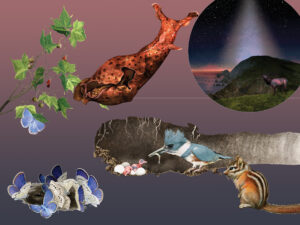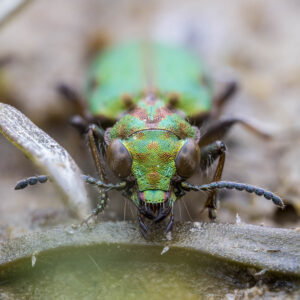A few years ago, John Hafernik, a biology professor at San Francisco State University, noticed a group of honey bees acting strangely, walking in circles on the concrete outside of his building on campus. He had recently acquired a pet praying mantis, so his first thought was: “Mantis food!” For days he scooped up the shambling bees into vials and fed them to his hungry pet. One vial of bees, however, sat forgotten on his desk. When he remembered the vial a week later, he was surprised to find it filled with partially decapitated bees and small, brown fly pupae.
The vial’s contents revealed that the mysterious parasite belonged to the family Phoridae, whose members include many species that are well known to parasitize ants, bees, and wasps. With roughly 4,000 species in this family (almost as many as all the known mammals), pinpointing the exact species was going to require research, and some highly specialized knowledge. Hafernik enlisted the help of fly experts at the Los Angeles Museum of Natural History. What they found was surprising — and ominous for the bees.
The honey bees were being parasitized by a native fly called Apocephalus borealis – also known as the “zombie fly.” Female zombie flies lay their eggs in the abdomens of the honey bees. A few days later their victims begin to exhibit erratic behavior, and eventually they embark on a one-way flight of doom from the hive. When they die, as many as 16 maggots hatch, pupate over the next couple of weeks, and give rise to more zombie flies.

Honey bees were brought to the United States by European colonists in the 1600s and have flourished up until fairly recently. In recent years, though, they have come under attack from various sources, such as fungal pathogens, viruses, Varroa mites, and pesticides. Scientists have suggested that interaction among the various pathogens and parasites causes what’s known as Colony Collapse Disorder (CCD).
The zombie fly is native to most of North America, and its natural hosts are bumblebees and paper wasps. It is likely that the fly started parasitizing non-native honey bees fairly recently. “Honey bees are among the best-studied insects,” Hafernik said. “We would expect that if this has been a long-term parasite of honey bees, we would have noticed.”
Researchers aren’t certain whether the zombie fly plays a role in CCD. But “zombees” do exhibit one of the main symptoms of CCD: hive abandonment behavior. Christopher Quock, a graduate student at SFSU, has been researching hive abandonment since 2009, and says there are several reasons why infected bees might leave their hives.
“It could be that they are simply kicked out of the hive by healthy bees, or perhaps they leave altruistically to protect the colony from infestation,” he said.
But there’s another option: zombie flies are using some sort of mind-control.
To test the mind-control idea, Quock is using a radio-tracking system with tiny chips glued to the bees’ abdomens that offer a 24-hour profile of activity into and out of his study hives. The data will help him determine whether parasitized honey bees leave the hive only at night, suggesting that the parasites are controlling them by changing the circadian rhythms of their hosts, or during the day as well, which would indicate that honey bees abandon their hives as a general response to stress or sickness.
Tracking the bees’ movements could lead to a better understanding of CCD as a whole, but it’s a daunting task. “Most healthy hives are being affected by a whole host of viral, parasite, and pathogen stressors,” Quock said. “It is a challenge to untangle that mess.”
For all they’ve learned in the last few years, Quock and his colleagues still have questions. How big a threat do zombie flies pose to honey bee colonies? And how widespread are they?
So far, they’ve sampled 33 sites in the San Francisco Bay Area, and of those 24 were infected with zombie flies. Since most bees embarking on night flights from their hive are found to be infected with the parasite, the easiest way to monitor presence of zombie fly infestation involves placing light traps near hives and monitoring the trapped bees for emergence of zombie fly larvae. Hafernik hopes that such a simple set-up will allow professional and amateur beekeepers to monitor their own hives and report back.
Hafernik and colleagues from the Los Angeles Museum of Natural History also launched a website, ZomBeeWatch.org, that enlists citizen scientists from all over the United States and Canada to report “zombee” sightings and upload pictures, which they can use to map out the spread of zombie flies. The fly has been documented at other sites in California, South Dakota, Oregon, and Washington, but has the potential to spread rapidly, given the common practice of shipping hives from state to state. So while zombie flies alone may be unlikely to create a zombee apocalypse, there is at least an eerie mystery for researchers to untangle.





